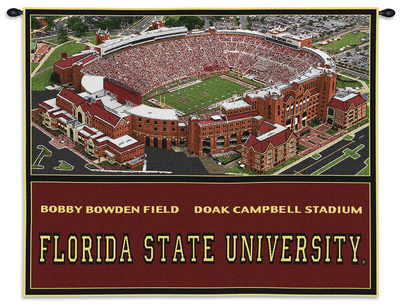
www.youtube.com/watch?v=CCAPja6hFPc&feature=player_detailpage
From a maximum capacity of 15,000 in 1953 to a record crowd of 84,347 in 2005 against Miami, Doak S. Campbell Stadium has risen along with the Florida State football program to the top of the college football ladder. In a special ceremony prior to the Florida game on November 20, 2004, the home of Florida State football took on a meaning even more special when Bobby Bowden Field was dedicated. With the final phase of construction completed, Seminole fans are welcomed to one of college football's greatest venues.
In 2008, the north endzone scoreboard was expanded from a video board that was 33 feet wide to a new 100 foot wide high quality digital board. The south endzone, which did not have any scoreboard prior to 2008, now has a 24'x45' video board. Also added in 2008 were 500 feet of ribbon board around the stadium. The LED displays, which are four-feet high, have been placed in all four corners of the stadium. There is also a ribbon board running under the scoreboard in the north endzone and one just below where the band is located on the south side. In 2007 a new sound system was installed improving the sound quality and smoothness. The system provides high quality sound to each and every person in the 83,000+ seat stadium. The newest structural portions of the stadium are a second deck of the Varsity Club in the northwest corner of the stadium and additional skyboxes leased through Seminole Boosters in the northeast corner. A brand new playing surface was installed in Summer of 2010. The entire floor of the stadium was excavated eight inches deep and the old pump drainage system was replaced with a complete wall-to-wall system built exactly to USGA golf green standards. The entire field was sodded with the same variety of 419 Tiftway Bermuda that the Seminoles have been playing on for most of the previous 12 years. The south endzone houses the Florida State school of hospitality education where students in the program receive hands-on experience in various aspects of the food and beverage industry. The multi-level facility includes a restaurant and a sports grill on the top floor that gives a panoramic view of Bobby Bowden Field at Doak Campbell Stadium. The north endzone, which consisted of wood bleachers until the 1994 season kicked off, is topped by the offices of the football coaches. The offices are just part of the Daisy Parker Flory wing of the Moore Athletic Center which include a number of amenities for the football staff. An even more drastic change came to completion in June of 2005 when the athletics department offices moved back into the newly rebuilt Moore Center. Towering above college football action from the east side are skyboxes, which stretch from goal line to goal line. New skyboxes are located above the west stands on the eighth floor. The west addition also houses the president's level on the seventh floor (which includes an open air terrace in the northwest corner) and one of the largest press boxes in college football with seating for over 250 members of the media. A brick facade surrounds the stadium, matching the architectural design of most of the buildings on the Florida State campus. The University Center surrounds Bobby Bowden Field at Doak Campbell Stadium and houses numerous offices that were located on the interior of the FSU campus. Inside the stadium, the lowest tier of field level seats were removed, providing increased sideline space and better viewing lines for the first few rows of fans. A matching brick wall was constructed along the east and west sidelines, limiting field access, increasing safety and giving the inside of the stadium a whole new look. In its last 130 home games, FSU is 113-16-1. Bobby Bowden's Florida State teams lost only 30 games at home in 32 years, giving the coach an impressive 164-30-2 record and an .842 winning percentage in Tallahassee. A milestone was reached on September 28, 1996 when Bowden won his 100th game in Doak Campbell Stadium as FSU's head coach with a 13-0 victory over North Carolina. In 2007 Bowden won his 300th career game at FSU right on the field that bears his name with a 24-16 win over Maryland. But the winning tradition of Doak S. Campbell Stadium, which was named after the former FSU president of the same name, goes back before Bowden. All-time, Florida State is 250-80-4 in 334 home games for a winning percentage of .754. Since the stadium opened on Oct. 7, 1950 with Florida State University taking a 40-7 victory over Randolph-Macon, millions of fans have packed Doak S. Campbell to see the finest in college football action. In 2006, Florida State set a single season attendance mark by drawing 644,256 fans over eight home games. The latest expansion is the ninth in the history of the stadium. The current capacity of 82,300 reflects an increase of 28,281 since the end of the 1991 season. Florida State first began play at Centennial Field during the inaugural 1947 season. In the three seasons that the Seminoles called Centennial Field their home, FSU had an overall home record of 8-4, including Coach Don Veller's undefeated 8-0 home mark over the 1948 and '49 seasons. It's hard to imagine the first Doak Campbell Stadium, with a capacity of 15,000 back in 1950 was built at a cost of $250,000. In 1954, the stadium grew to a capacity of 19,000. Six thousand more seats were added in 1961. During the Bill Peterson era (1960-70) the stadium was expanded to 40,500 seats and it remained at that capacity for the next 14 years. Between 1978 and 1982, there were three more additions. Doak Campbell continues to grow and improve and has become a fitting showcase for Florida State University.


